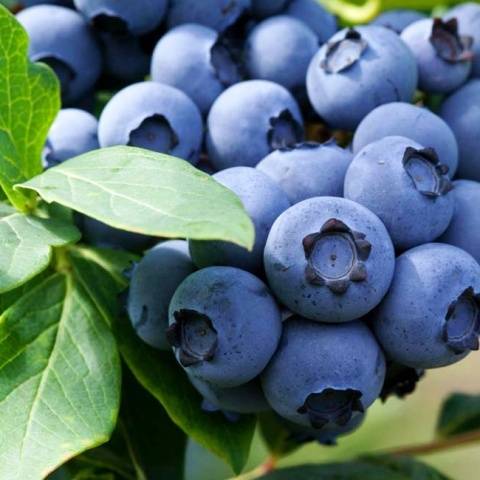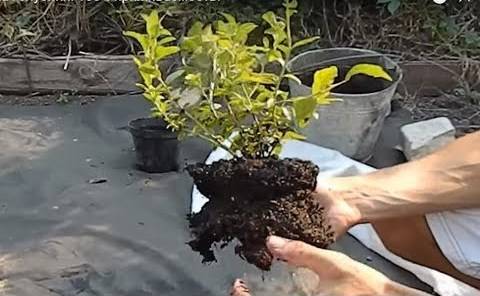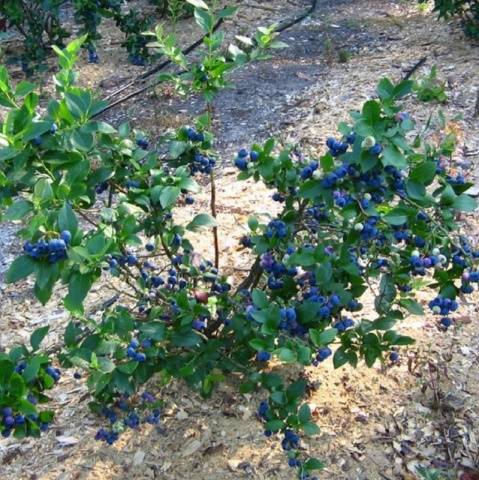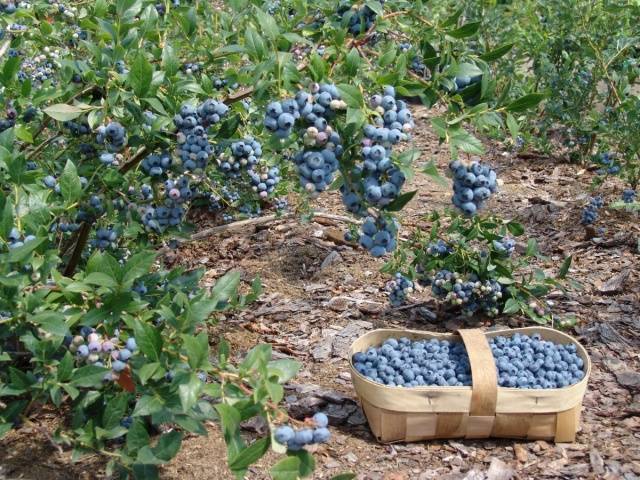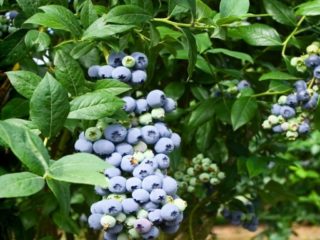Content
Liberty blueberry is a hybrid variety. It grows well in central Russia and Belarus, it is cultivated in Holland, Poland, other European countries, and the USA. Suitable for industrial cultivation.
Breeding history
The tall blueberry Liberty was bred in Michigan (USA) by an experienced breeder D. Hank in 1997. The source material for the variety was Brigitte Blue and Eliot blueberries. Thanks to them, Liberty has a high yield and late ripening. The hybrid was patented in 2004.
Description of berry culture
The variety has all the characteristic features of this berry culture.
General ideas about the variety
The height of the bush reaches one and a half meters and is 1.2 meters in diameter. The bush grows voluminous, covered with tough green elliptical leaves, pointed at the end.
Berries
The berries are blue, covered with a white waxy coating, dense. They are collected in bunches. They are 13 mm long and up to 15 mm in diameter. The average weight of one berry is 1.5 g.
Sweet and sour, aromatic. They are easily torn off the bunch, well stored and transported. Dessert variety, widely used in cooking. Tasting score 4.5 points.
Characteristic
The characteristic of Liberty blueberry indicates a late ripening variety, but the berries ripen before frost.
Main advantages
Liberty belongs to frost-resistant varieties, it can be grown in the regions of the Far East and Siberia. Just to keep the plant in such a climate in winter, you need to make a reliable shelter.
The culture requires constant moisture. Stagnation of water is unacceptable. To prevent the soil from drying out, the trunk circle is mulched with coniferous litter or sawdust.
Blueberries, subject to the rules of agricultural technology, grow and bear fruit well. The main requirement is acidic growing soil.
Flowering period and ripening time
The plant blooms in May, the first crop is harvested in August. This variety belongs to the late blueberry species.
Yield indicators, fruiting dates
High Liberty blueberries yield about 6 kg of berries per bush. Fruiting from August to late September. You can harvest two crops per season.
Scope of berries
Blueberries are healthy and tasty fresh. Jams, compotes, preserves, pie filling, jelly and marmalade are made from berries. Freeze is used for winter storage.
Disease and pest resistance
This blueberry variety is resistant to moniliosis, anthracnose.
Advantages and disadvantages of the variety
Breeders from the USA have kept the best qualities in the Liberty blueberry variety.
Garden blueberry Liberty has the following benefits:
- High productivity.
- Unpretentious care.
- Frost resistance.
- Growth in various climatic conditions.
- Delicious and healthy berries.
- The ability to transport them and keep them fresh for a long time.
Disadvantages - the need for winter shelter in the northern regions.
Landing rules
Blueberries require certain conditions to grow successfully.
Recommended timing
Tall blueberries Liberty are planted in the ground in spring and autumn. Spring planting is preferable. It is April-May before bud break. Spring planting is more reliable for plant survival.
Choosing the right place
Blueberries love an abundance of sunlight, the planting site requires good sunlight, there should be no groundwater in the root area, stagnant melt water.
Soil preparation
Liberty blueberries should be planted in acidic soil with a pH of 3.5-5 units. The soil should be fertile, it is useful to add peat. Before planting, the bed must be dug up, removed weeds.
Selection and preparation of seedlings
2-3 year old bushes are suitable for this purpose. You should choose seedlings in pots with closed roots, planted in acidic soil.
It is worth paying attention to the condition of the plant, it should have a healthy look, green leaves and brown bark. You should choose seedlings zoned to a specific region.
Algorithm and scheme of landing
Planting Liberty blueberries is as follows - for a start, pits are prepared. Their depth is about half a meter, between the plants there is a gap of one meter. Placed in rows at a distance of one and a half to two meters. Blueberries love free placement; planting bushes and trees nearby is not worth it.
The algorithm for planting seedlings is as follows:
- The seedling pots are filled with water and kept for three hours.
- The plant is removed from the pot and placed in a hole. The roots are straightened, sprinkled with soil.
- Water the seedling until the water is completely absorbed.
- Planting is mulched with peat.
- Two-year-old seedlings are buried 4 cm more than they were in the pot. The younger ones are smaller.
We offer you to watch a video about planting Liberty blueberries.
Follow-up care of the culture
Planting and caring for high liberty blueberries includes: watering, feeding, loosening and mulching.
Necessary activities
Proper and timely watering of the plant is required. Blueberries are a moisture-loving culture. To increase the acidity of the soil, table vinegar is added to the water - 100 g per bucket of water.
Do not forget about feeding. All the main elements are introduced - nitrogen, phosphorus, potassium, trace elements.
One of the important fertilizers is nitrogen. The main part is brought in at the beginning of the season, the rest of the rate is divided into June-July, in the future, nitrogen is not used.
Loosening the trunk circle and mulching it. To maintain the acidic reaction of the soil, it is mulched with coniferous needles, peat or bark.
Shrub pruning
Formative pruning is done in the first year after planting. This will create a healthy shrub with strong skeletal branches. In the future, with annual pruning, diseased and broken shoots, as well as thickening branches, are removed.
Anti-aging pruning is done every year. Remove two-year-old shoots from which the berries were removed. This results in a higher yield and larger berries.
Preparing for winter
In most regions of Belarus, Central Russia, adult blueberry bushes can winter without shelter. For them, it is enough to fertilize with mineral fertilizers without nitrogen in August and mulch the trunk circle with peat or sawdust.
Young plants are covered with agrofibre or huts are made from spruce paws. You can grow blueberries in containers. For wintering, they are brought into a room or greenhouse.
Collection, processing, storage of crops
Berries in small areas are harvested by hand, they easily come off the bunch, while not letting in the juice. In industrial cultivation of berries on large plantations, mechanized harvesting is carried out.
The berries can be kept in the refrigerator for a while. For winter storage, they are frozen. Processing of blueberries into jams, preserves, compotes and juices is possible.
Diseases and pests, methods of control and prevention
The main diseases of culture and methods of combating them are presented in the table.
Blueberry diseases | Characteristic | Control methods |
Phomopsis mushroom | Young shoots twist and dry up. Red spots are visible on the leaves | Treatment with Bordeaux liquid in spring and autumn, the use of antibiotics. The diseased parts must be cut and burned. Avoid waterlogging |
Gray rot | Red spots appear on all parts of the plant, then turn gray | Spray plants with Bordeaux liquid, be sure to the bottom of the leaves. It is good to use "Fitosporin". Work the soil under the plant. Avoid excessive moisture |
Mosaic
| Leaves are affected. Yellow mosaic spots appear on them. The source of the disease is a tick | Treatment with fungicides, preparation "Aktara", it is safe to use "Fitoverm". A diseased plant cannot always be cured, then it is removed. To avoid disease, crop rotation should be observed. |
Red ring spot | Red rings appear on old blueberry leaves that cover the entire plant and destroy it. | Similar to mosaic prevention and control |
Blueberry pests | Characteristic | Control measures |
Aphid | The tops of the shoots and leaves are curled, inside them a continuous layer of small insects is visible. Leaves are damaged. Carry viral diseases | Destroy the ants that carry the pest through the plants. Treat the plant with "Fitoverm" or ammonia solution |
Flower beetle | Damages buds and buds. A small beetle is visible on them | Treatment with "Fitoverm" or insecticides such as "Aktara", "Healthy Garden" |
Leaf roll | Eats buds and leaves, wraps them in cobwebs | The actions are the same as with the color beetle |
Blueberry Liberty requires care that is somewhat different from other berry crops. The main requirement is to plant the plant in acidic soil. Further care is not at all difficult, so you can get a good harvest by first starting to grow this crop.
